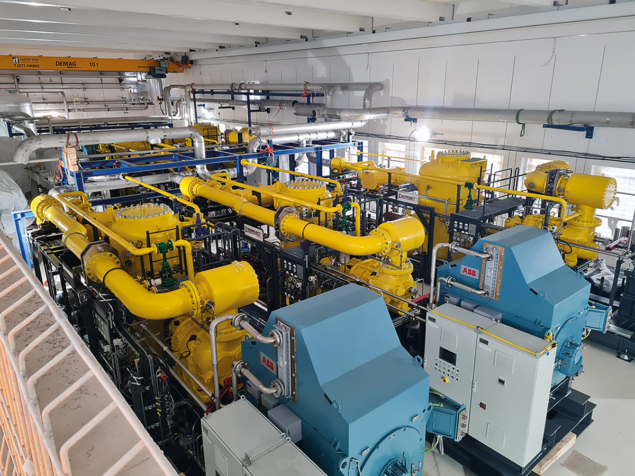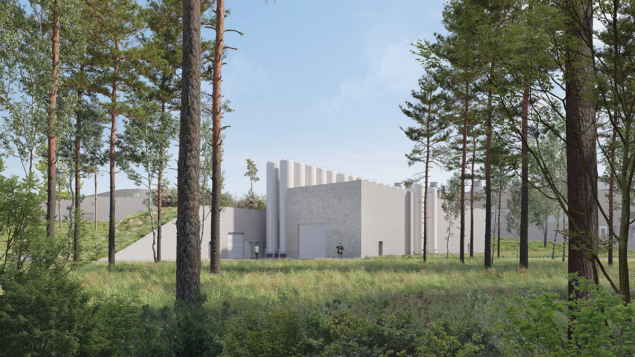Cryogenics is a core enabling technology in the Facility for Antiproton and Ion Research (FAIR), which is under construction in Germany. Joe McEntee talks to Holger Kollmus and Marion Kauschke – who together head up the cryogenics programme at FAIR – about the secrets of success at ultralow temperatures.

The Facility for Antiproton and Ion Research (FAIR) in Darmstadt, Germany, represents an ambitious reimagining of the GSI Helmholtz Center for Heavy Ion Research, one of Europe’s leading accelerator research laboratories. When it comes online for initial user experiments in 2027, FAIR will provide scientists from around the world with a multipurpose accelerator complex that’s built to address a broad-scope research canvas – everything from hadron physics, nuclear structure and astrophysics to atomic physics, materials science and radiation biophysics (as well as downstream applications in cancer therapy and space science).
At the schematic level, FAIR will generate primary beams – from protons up to uranium ions – as well as secondary beams of antiprotons and rare isotopes. As such, the accelerator facility is optimised to deliver intense and energetic beams of particles to different production targets. The resulting beams will subsequently be steered to various fixed-target experiments or injected into specialist storage rings for in-ring experiments with high-quality beams of secondary antiprotons or radioactive ions.

Underpinning all this experimental firepower are FAIR’s main building blocks: the fast-ramping SIS100 synchrotron, which provides intense primary beams; the Super Fragment Separator (Super-FRS), which filters out the exotic ion beams; and the storage rings (see “From here to FAIR”, below). Meanwhile, the existing GSI accelerators (UNILAC and SIS18) will serve as injectors and pre-accelerators for SIS100, while a new proton linac will provide high-intensity injection into the synchrotron chain. Here Holger Kollmus and Marion Kauschke – head and deputy head, respectively, of the GSI/FAIR cryogenics programme – tell CERN Courier how the laboratory’s cryogenic infrastructure and specialist expertise at ultralow temperatures are fundamental to FAIR’s long-term scientific mission.
Let’s start with the basics. How has the cryogenics programme at GSI evolved as FAIR moves from concept to reality?
HK: While cryogenics does not have an extensive back-story at GSI – only two large-scale experiments have deployed superconducting magnets to date – the strategic decision to build FAIR put ultralow-temperature technology at the heart of GSI’s development roadmap. Consider the requirement for specialist infrastructure to provide at-scale testing of FAIR’s superconducting magnets. A case in point is the Prototype Test Facility (PTF) which, between 2005 and 2012, was used to evaluate five candidate magnet designs. One of these prototypes, the so-called first-of-series (FOS) magnet, was subsequently specified for the SIS100 ring (110 dipole magnets in total, with two spares).

It soon became clear, however, that the PTF’s single test stand was not fit-for-purpose to validate all of the magnets within a reasonable timeframe. Instead, that task was allocated to the Series Test Facility (STF), which came onstream in 2013 with cryogenic plant and equipment provided by Swiss manufacturer Linde Kryotechnik. Informed by lessons learned on the PTF, the STF maximised throughput and workflow efficiency for large-scale testing of the SIS100 dipole magnets.
How did you realise STF workflow efficiencies?
MK: Custom building design and layout are key, with a slide system for the superconducting magnets under test, a bellows-free mounting and accessible interfaces between the feed box, magnet and end box. The feed box and end box enclose the superconducting magnet on both sides for testing, with the former additionally supplying the magnet with liquid helium coolant and electrical current. The liquid helium keeps the magnet at a constant 4.5 K, while shielding (maintained between 50–80 K) reduces any heating of the cryogenically cooled magnet (the so-called “cold mass”).

At the same time, the compressor and STF cold box for the liquid helium are physically separated in an adjacent building, thereby minimising noise and vibration levels in the test environment. The cryogenic distribution system is installed on a gallery to enhance staff access between the four test stands, while the cold box itself has a cooling power of 800 W at 4–5 K, 2000 W at 50–80 K and a liquefaction capacity of 6 g/s.
All of the SIS100 dipoles have now been tested in the STF, with the facility’s four test stands allowing for “four-stroke” operation. Put simply: on one test stand, the magnet is assembled; the second is in cool-down; the third is cold and the magnet is under test; and the fourth is in warm-up mode. This resulted in each magnet being in the STF hall for about a month, with delivery of one new magnet each week. Worth noting as well that if any magnets had failed under test – though none did – they would have been taken to the PTF without interrupting the “assembly-line” work.
Does that mean the PTF and STF will now be decommissioned?
MK: The R&D activity at the PTF and STF is far from over. One dipole magnet is undergoing endurance testing in the PTF, while the STF is being used to test SIS100 quadrupole modules as well as prototypes of other SIS100 and Super-FRS components (such as the transfer lines needed to distribute liquid helium from source and feed boxes for the SIS100 and Super-FRS). When testing at the STF is complete – most likely in 2028 – two of the four test benches will be dismantled and part of the hall will be repurposed for a superconducting CW linac (to be cryogenically supplied by the STF).
Presumably, the GSI cryogenics team engages with other large-scale facilities to enhance its R&D and test capabilities?
HK: That’s correct. The testing of superconducting magnets requires technical personnel with specialist domain knowledge and expertise to measure and validate magnetic and electrical properties; provide the cryogenic supply within certain temperature/pressure limits; as well as to measure the magnet calorimetrically (for example, with regard to its heat load).

CERN, as a pioneer in superconducting magnets for high-energy physics, is one of our main technology partners. As such, the superconducting magnets for the Super-FRS – dipoles as well as multiplets – are undergoing acceptance testing at CERN on their way to Darmstadt from the manufacturers in Italy, France and Spain. Another joint effort is focused on FAIR’s cryogenic machine control, transferring established solutions for the control of valves, temperature/pressure sensors and a range of other subsystems using the CERN software UNICOS.
So collaboration and knowledge exchange are fundamental to project delivery?
HK: Partnership with other cryogenics groups across Europe underpins our deployment model. The equipment needed for local cryogenic distribution to the magnets, for example, is provided by an in-kind contribution from Wroclaw University of Science and Technology (WUST) – tapping into the Polish team’s work on other large-scale cryogenics projects including the European Spallation Source (ESS) in Sweden and the European XFEL here in Germany. Another strategic R&D partner is the Test Facility for large Magnet and superconducting Line (TFML) in Salerno, Italy. Part of the Istituto Nazionale di Fisica Nucleare (INFN), the TFML’s refrigeration capacity and testing facility are available for SIS100 quadrupole testing, thereby opening up test capacity at GSI for other cryogenic components/subsystems such as feed boxes and current lead boxes. The latter enable the warm-to-cold transition for the electrical current, on the way from the “warm” power converter to the “cold” magnets.
Where are the big crunch-points for cryogenic cooling within FAIR?
HK: The SIS100 and the Super-FRS are the principal consumers in terms of FAIR’s cryogenic cooling capacity – each with a cold connection to a single large refrigeration plant called CRYO2. The SIS100 (with a circumference of 1100 m) is characterised by high dynamic-load changes with a duration of several hours. In terms of design, the ring comprises an array of dipole and quadrupole magnets in a configuration that exploits an internally cooled superconducting cable (with the superconducting strands cooled using two-phase helium).

Operationally, the SIS100 magnets have to be ramped during the acceleration of the heavy ions, with the ramp and repetition rate adapted to the ions and experimental set-up to yield different heat loads at the 4 K level. The change between these different cycles should be as short as possible (of the order of less than one hour), with control of the supply pressure inducing different helium flows for the magnet cooling.

Meanwhile, the Super-FRS (at 350 m long) will contain 1500 tons of cold mass that must be cooled in a realistic timeframe (typically one month). A dedicated cool-down and warm-up unit (CWU), using liquid nitrogen as coolant for a helium circuit, is pivotal in this regard and fulfils the Super-FRS requirements with respect to maximal cool-down rates and temperature differences.
What are the challenges of integrating FAIR’s cryogenic infrastructure with the existing GSI facilities?
MK: FAIR’s main cryogenic supply building comprises two independent halls, each having its own foundations. The front hall – which houses the cold box, distribution lines and cryogenic gas management – connects to the SIS100 tunnel via pillars and an arrangement that’s designed to avoid any movement of the transfer line supplying supercritical helium to SIS100. Whereas the rear section – which houses the compressor station – sits on a “floating foundation”, essentially decoupled from the cold-box hall to minimise the impact of any resulting ground-based vibration on the SIS100 ring.
FAIR’s cold, cold heart

FAIR’s central cryogenic plant, CRYO2, is already installed and will provide a cryogenic capacity of 14 kW at 4–5 K and 50 kW at 50–80 K. Those figures of merit will ultimately enable parallel and independent operation across FAIR’s main cryogenic consumers – servicing, for example, the varying heat loads of SIS100 (for operation of different machine cycles) as well as accommodating the large cold mass of the Super-FRS (and its liquefaction requirements). Campus-wide, the cold helium is transported to the FAIR machines by a 1.5 km long distribution system, the installation of which is well under way.
At the heart of CRYO2 is a helium refrigerator in tandem with oil-cooled screw compressors. To optimise long-term adaptation to load changes, the mass flow-rate of coolant will be regulated in near-stepless fashion using a variable-frequency driver for the compressors. The compressor station itself is set up from five compressor skids, each having its own oil system and including a rough separation of more than 99% of the oil from the process gas. The rest of the oil is separated on the high-pressure side before the gas enters the cold box. As the CWU operates independently from the CRYO2 plant, this compressor has its own oil removal system.
A host of other design issues have also come into play, so adaptability is key. For starters, given that FAIR is situated in a wooded recreation area for neighbouring communities, the height of the helium storage tanks is limited to the height of the average tree in the vicinity. In the same way, FAIR’s cryo buildings will integrate seamlessly with their surroundings – with the use of roof greening, for example, and a window-free design to cut out light pollution. Energy efficiency is also a priority, with the heat that’s generated during the cryogenic compression process to be recovered and used for heating in other parts of the FAIR facility, while active noise mitigation of the air-conditioning systems will minimise disturbance to wild animals.
How is the roll-out of FAIR’s cryogenic plant progressing?

HK: The installation of the cryogenic supply infrastructure in the cryogenic building will be finished this autumn, with the supporting infrastructure – including the electrical supply and cooling water – to be in place before spring 2025. Commissioning of the full cryogenic supply system is scheduled to complete by the end of 2025, with the first experiments at FAIR using superconducting technology to follow in 2027.








